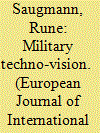| Srl | Item |
| 1 |
ID:
169977


|
|
|
|
|
| Summary/Abstract |
The flourishing of photography as a tool for expressive reportage and artistic practice transformed photographic education during the mid-twentieth century. American-based academic institutions quickly established reputations in the emerging fine art field as leaders in photographic education drawing international students from diverse locations, including Israel. Many Israelis who studied photography in American institutions returned to Israel bringing with them the knowledge they had gained while abroad. This article considers the impact of American pedagogical models and social networks on the development of the Israeli photographic field. Included in this discussion is an exploration of the emergence of Israeli photography programs in institutions of higher education, photography galleries, museum collections, and exhibitions. By approaching the study through a network methodological approach, this article traces the transnational movements of individuals: photographers, program graduates, and curators in order to demonstrate the significant impact American photographic education had on the emerging Israeli photographic field.
|
|
|
|
|
|
|
|
|
|
|
|
|
|
|
|
| 2 |
ID:
169162


|
|
|
|
|
| Summary/Abstract |
Military applications of technologies for enhancing or producing vision play a key role in composing contemporary security, as such technologies are deployed to make security sense of everyday sociality, of battlefields, and of much in between these extremes. In this article, I set out to recompose militarised techno-vision through the public detritus left by its heterogenous development, use, and appropriation. I argue that as an heterogenous and amalgamated object, military techno-vision can be composed by speaking the stories of its leftovers, and that this composition is characterised by and in turn characterises a longstanding dilemma between fact and vision – between the ambiguity that is constitutive of the human practices of visual perception and image-making, and the desire for machines that can produce visual ‘actionable intelligence’ that can underpin security decisions. Discourses, practices, and regimes of visibility are deployed alongside technologies to occlude the ambiguity of technological vision and sustain the imaginary of technologically altered vision as neutral production of military or security facts.
|
|
|
|
|
|
|
|
|
|
|
|
|
|
|
|